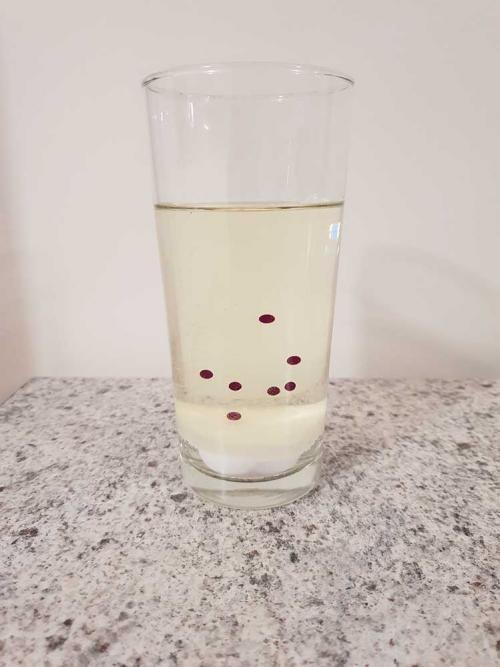Although this isn’t quite the same as a lava lamp that you buy, it is a very exciting and visually spectacular experiment. It is very safe, using only things you would usually find in your kitchen.
There are a number of ways that you can do this experiment. This one is my favourite because it is very easy to control how fast it goes. If you start slowly, this experiment can last for hours. Alternatively, you can speed it up, which will make it finish sooner, but looks very cool.
What you need
- Citric acid powder
- Bicarb soda (sodium bicarbonate)
- Cooking oil (the lighter in colour, the better)
- Food colouring (multiple colours for the best effect)
- Tall see-through container (I usually use a 250 mL measuring cylinder, but a tall narrow glass or vase works as well.)
What to do
- Mix together approximately equal amounts of the citric acid and bicarb soda. You need enough to have the mixture about 1 cm deep in the bottom of the container.
- Very gently, slightly tilt the container and pour cooking oil down the side of the glass so that it sits on top of the citric acid–bicarb soda mixture. You can use as much as you like, depending on how big the container is.
- Sit the container upright on a flat surface.
- Add a few drops of food colouring to the top of the oil layer. Use only one or two colours. They will eventually mix, and if you use all colours you’ll end up with a boring black colour.
- Watch and enjoy!
- The food colouring drops sink, allowing the citric acid and bicarb soda to mix together and form bubbles. The bubbles attach to the outside of the food colouring drop, which is then carried back to the surface of the oil layer. The bubbles should then pop, and the food colouring drop sinks back down to the bottom. The cycle continues until either the citric acid or the bicarb soda runs out.
If you want to speed it up, just add more food colouring drops. Alternatively, you could add water drops, which will lighten the colour of the food colouring drops. For another fun effect, you can shine a desk lamp through the lava lamp in a dark room against a light-coloured wall.
What’s happening?
There is so much science going on here!
- Acid–base reactions: The citric acid and the bicarb soda are an acid and a base, which can react with each other. However, as solid powders they do not react with each other – they must be dissolved in water and do not dissolve in the oil. The base in this reaction is a carbonate, so when it reacts with an acid it forms carbon dioxide bubbles.
- Density: The food colouring drops are mostly water. Water is denser than cooking oil and also does not mix with it, which means that when dropped on the top it sinks to the bottom of the container. However, when the carbon dioxide bubbles are attached, the combined food colouring drop and bubble is less dense than water, so it floats back up to the top. When the bubbles pop and the gas is released, the food colouring drop becomes denser than the oil again, and sinks back down.
- Colour: When the food colouring drops mix together, the colours blend together too. The colour for the food dyes is determined by what colours of light they absorb, and what colours they reflect. When they mix together, the combination of different colours makes the drop appear to be one colour; for example, red and yellow mixed together make orange. If you were able to look really closely (you can’t), you would be able to see that the food dyes are still yellow and red.
I hope you enjoy this experiment! If you have any questions or feedback, I can always be contacted by email so feel free to get in touch anytime!
Until next time, happy sciencing!



